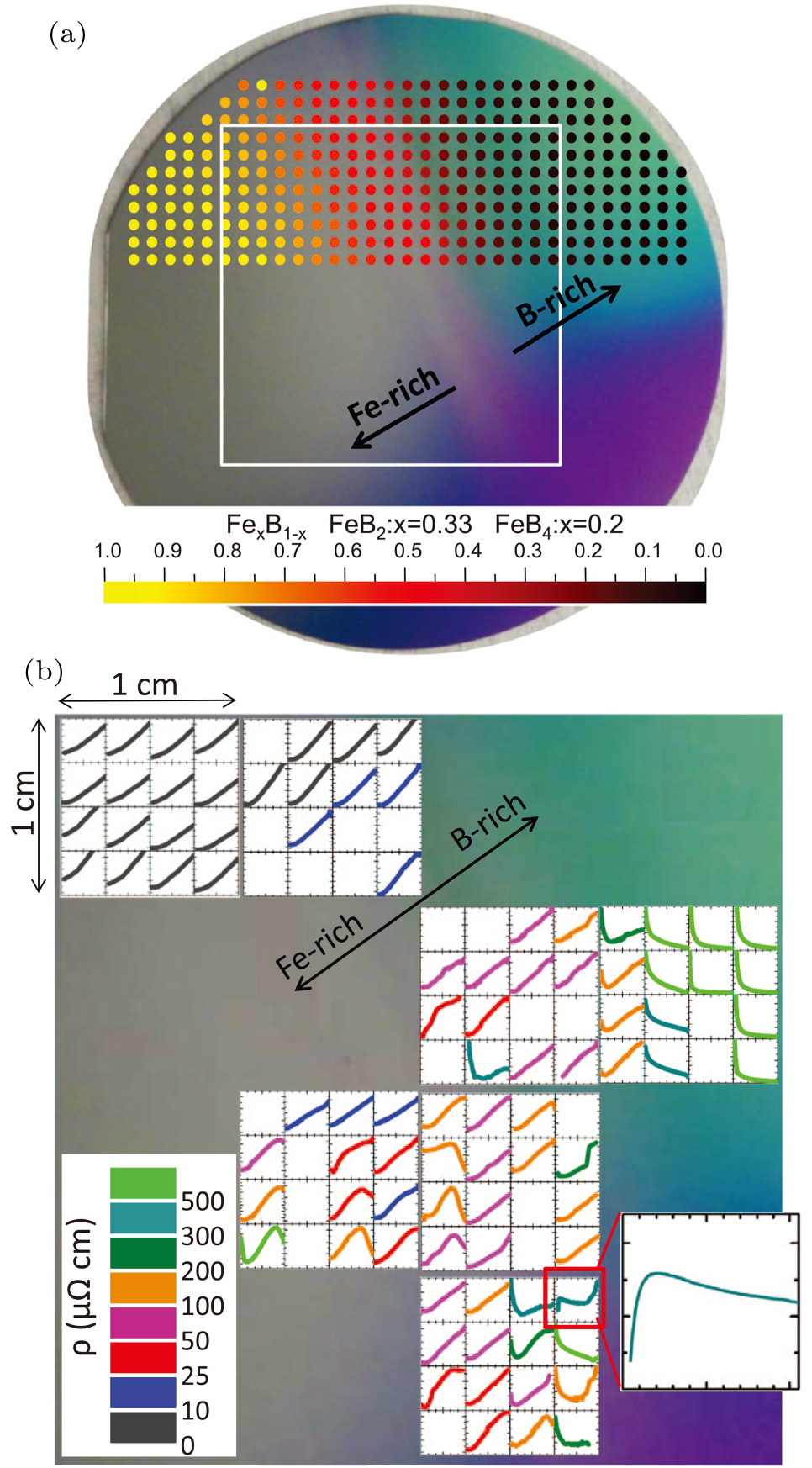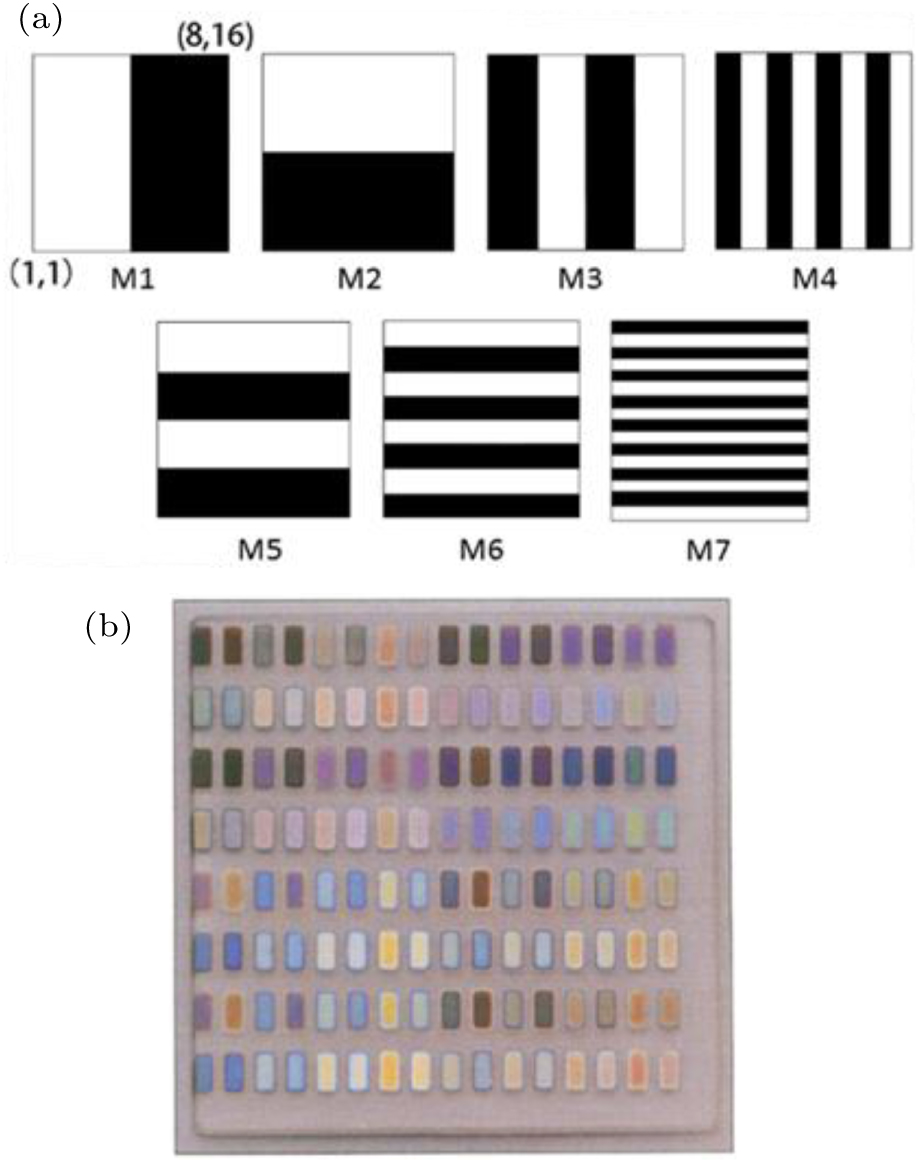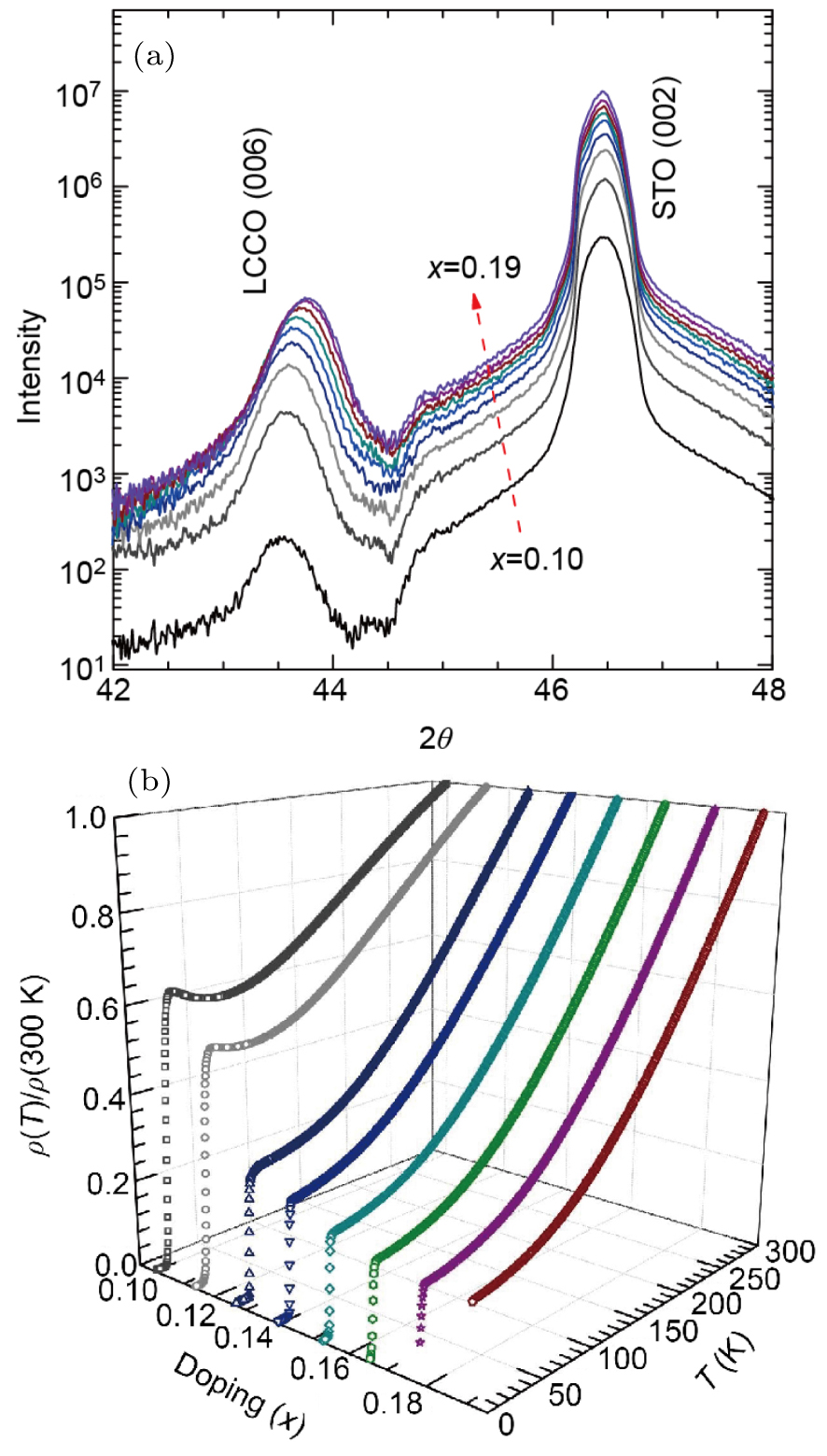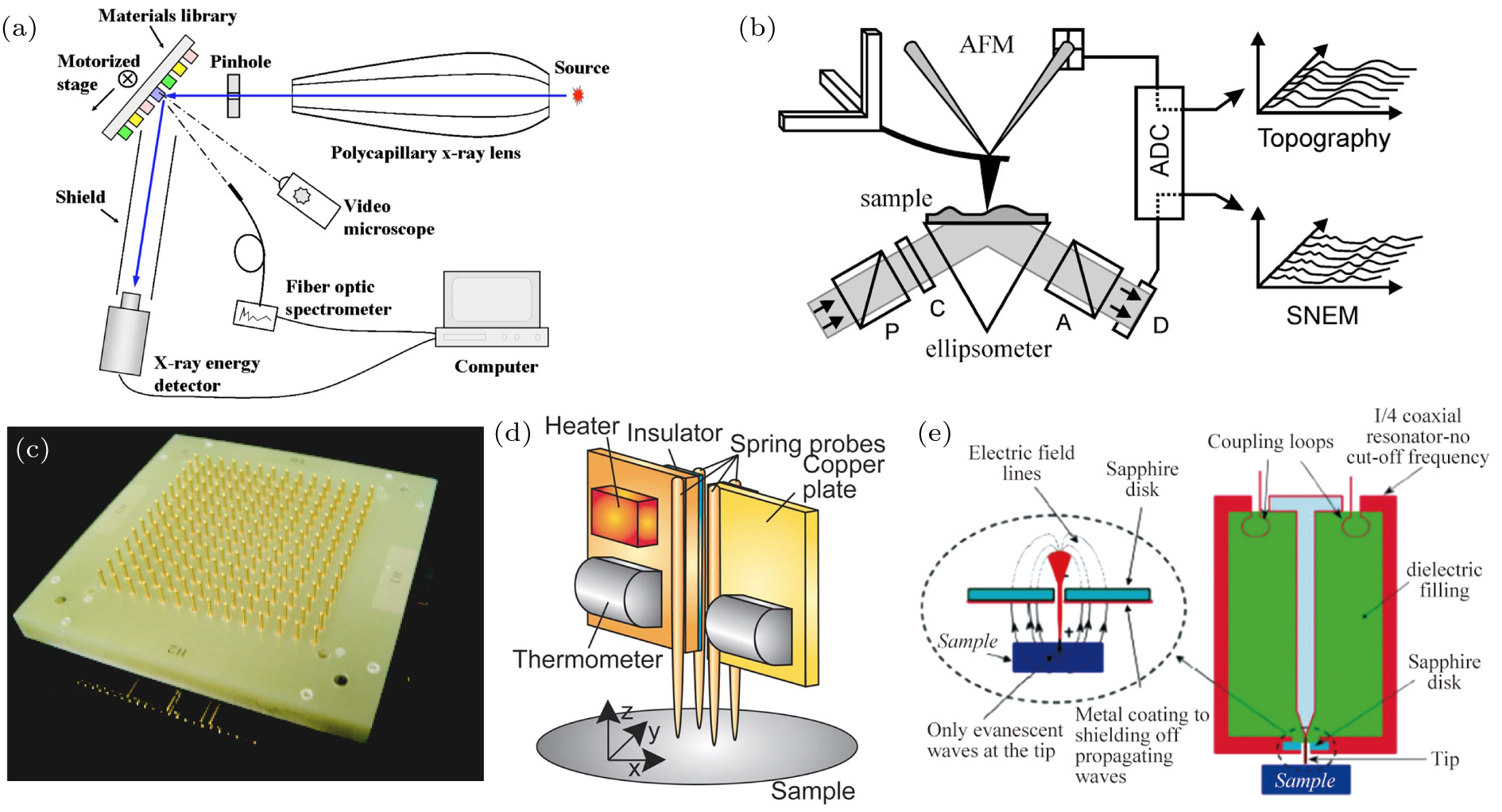† Corresponding author. E-mail:
Project supported by the National Key Basic Research Program of China (Grant Nos. 2015CB921000, 2016YFA0300301, 2017YFA0303003, and 2017YFA0302902), the National Natural Science Foundation of China (Grant Nos. 11674374, 11804378, and 11574372), the Beijing Municipal Science and Technology Project (Grant No. Z161100002116011), the Key Research Program of Frontier Sciences, Chinese Academy of Sciences (Grant Nos. QYZDBSSW-SLH008 and QYZDY-SSW-SLH001), the Strategic Priority Research Program of the Chinese Academy of Sciences (Grant No. XDB07020100), and the Opening Project of Wuhan National High Magnetic Field Center (Grant No. PHMFF2015008).
As an essential component of the Materials Genome Initiative aiming to shorten the period of materials research and development, combinatorial synthesis and rapid characterization technologies have been playing a more and more important role in exploring new materials and comprehensively understanding materials properties. In this review, we discuss the advantages of high-throughput experimental techniques in researches on superconductors. The evolution of combinatorial thin-film technology and several high-speed screening devices are briefly introduced. We emphasize the necessity to develop new high-throughput research modes such as a combination of high-throughput techniques and conventional methods.
High-temperature superconductors are promising materials for applications in the fields of lossless power transmission, magnetic levitation transport and magnetic resonance imaging to name a few, but the practical applications are limited by the lack of appropriate materials. Therefore, it is of great importance to investigate the mechanisms of high-temperature superconductivity and explore new superconductors with suitable performance parameters such as the transition temperature (Tc) and the critical current density. The essential task of establishing a complete and accurate phase diagram for high-Tc superconductors is faced with two obstacles. First, combining more than a few elements appears to be a promising route for pursuing high-temperature superconductivity, given the fact that the record of Tc ∼ 138 K at ambient pressure is currently maintained by the six-element superconductor Hg0.8Tl0.2Ba2Ca2Cu3O8.33.[1] However, the amount of studies performed on compounds with large number of element is limited. Besides, the properties of high-temperature superconductors are extraordinarily sensitive to the proportion of its constitutive elements.[2,3] For instance, changing the cation doping concentration on the order of 1% in cuprates such as La2CuO4 can lead to transitions between insulator, metal, and superconductor.[4] A slight difference in oxygen content significantly impacts the properties of oxide superconductors also.[5] Second, there are many variables such as doping[6] and pressure[7] in the phase diagrams of superconductors. It is difficult to experimentally achieve consistency in some of these synthesis parameters among samples batches, leading to significant uncertainty in the phase diagrams. The inaccuracy of phase boundaries makes it non-trivial to study the phase transition behavior around the critical points.[8] In other words, the multi-element and multi-variable nature of synthesis conditions of unconventional superconductors represents a significant challenge to the efficiency and precision of materials exploration. A new approach is required to change the slow and serendipitous trial-and-error process.[9,10] Fortunately, high-throughput materials synthesis and characterization methodology, which has been developed over the last two decades, has proved to be capable of accelerating materials exploration.[11–15] The high-throughput experimental strategy is considered as one of the three key components of the Materials Genome Initiative (MGI).
What is the genome in the MGI? First, materials “genes” represent the elementary units determining the characteristics of a class of materials, e.g., copper–oxygen planes in cuprate superconductors. Second, preparation of materials libraries and their rapid screening are central to the MGI. This is analogous to the antibody preparation technology in biological genetic engineering, where the strongest antibodies are selected and cultured. This strategic methodology launched in 2011 by the former president of the United States, Barack Obama, aims to develop new materials research and development procedures and set up efficient information sharing mechanisms.[16] The MGI activities mainly consist high-throughput computations and synthesis, rapid characterization, and establishing comprehensive material databases.[17] Combined with information technologies such as machine learning, high-throughput calculations and simulations will help to achieve intelligent design and streamlined investigation of new materials. It is believed that credible predictions could be made in a short time[18,19] to guide experiments and increase the probability of discovering desired materials.[20] High-throughput synthesis technologies can be used to continuously change parameters such as materials growth temperature[21] and doping concentration.[22,23] In this way a series of samples can be synthesized in parallel so that the preparation time is significantly shortened. High-throughput characterization methods with high spatial resolution can perform micro-region detection and continuous scanning.[24] Appropriate high-speed screening instruments including in-situ characterization of structure, composition, and other physical properties will benefit establishment of materials databases.[25] Accordingly, the implementation of the MGI will shorten the research and development cycle of new materials effectively and save costs. In this manner, high-throughput techniques can benefit the research on superconductivity.
As an essential part of the MGI, high-throughput materials synthesis and characterization technology, whose central idea is to move from sequential iteration to parallel processing plays a critical role in transformation from experiential methods to predictive methods. We will briefly summarize the development of combinatorial thin-film growth technologies and rapid characterization methods applied to superconducting thin films. More comprehensive and detailed descriptions of combinatorial approaches are available in other reviews.[10–12,14]
The first report of combinatorial thin films using the co-deposition method, dates back to 1965.[27] Kennedy et al. quickly obtained the Fe–Cr–Ni ternary library on an equilateral-triangle metal foil with a side length of 10 inch (1 inch = 2.54 cm) by electron–beam co-evaporation. This technique offers an efficient way to map phase diagrams,[28] which is of key importance to explore new superconductors. In 2013, Jin et al. took advantage of the composition spread technique to confirm the superconductivity in the Fe–B binary system.[26] They fabricated by co-sputtering the Fe–B binary compositional phase space across 3-inch Si wafers with a 200-nm SiO2 layer on top.[29] Figure
 | Fig. 1. (color online) Composition and resistance measurements of the Fe–B binary compositional phase space. (a) A 3-inch-diameter (1 inch = 2.54 cm) composition spread wafer. (b) Mapping of the temperature dependence of resistivity on the composition spread film.[26] |
The second generation of combinatorial films appeared in 1990s.[31] Xiang et al. developed a method combining thin film deposition and physical masking techniques in order to realize the parallel synthesis of spatially addressable libraries of solid-state materials. They generated material libraries on MgO and LaAlO3 single-crystal substrates by sputtering target materials (CuO, Bi2O3, CaO, PbO, SrCO3, Y2O3, and BaCO3) through physical masks, as shown in Fig.
 | Fig. 2. (color online) Combinatorial material chip technology. (a) Binary masks used for library synthesis. The numbers at the lower left and upper right corners indicate its orientation with respect to the coordinates of the library members. (b) A 128-member binary library prior to sintering. Each site is 1 mm by 2 mm.[12] |
Combinatorial laser molecular beam epitaxy (CLMBE), the so-called third generation of combinatorial thin-film preparation technology, was developed to carry out parallel fabrication by atomic layer-by-layer process.[10] The state-of-the-art laser molecular beam epitaxy is used in combination with the continuous moving mask technique[36] to control layering sequences which is supposed to avail the fabrication of high-quality superconducting films. The procedure for preparing binary combinatorial films with continuous chemical composition spread on a single substrate is briefly descripted as follows (see Fig.
 | Fig. 3. (color online) Schematics of the binary-combinatorial-film growth using the continuous moving mask technique.[23] |
 | Fig. 4. (color online) The characterization of the combinatorial La2–xCexCuO4±δ films. (a) Micro-region x-ray diffraction results. (b) Temperature dependence of the resistivity of different micro-regions in the film.[23] |
Although the combinatorial thin-film preparation methods elaborated above provide spatially addressable arrays of compositions, the annealing process is also required for phase formation.[41] This thermodynamic process can be realized by parallel method or discrete method.[12] The parallel method implies that one piece of combinatorial film is placed at a specific temperature. It is proved to help fabricate high-quality epitaxial combinatorial materials.[42] The discrete method consists in placing points of the material library under different heating processes for the sake of high-throughput phase formation.[43] In addition, oxygen concentration plays a crucial role in cuprate high-Tc superconductors. But there is not any feasible method for high-throughput oxygen control, showing that more effort should be paid to the high-throughput preparation technology.
In addition to high-throughput preparation, rapid characterization of combinatorial films is also a key point in the research on superconductivity. At present, the tools used for high-throughput characterization always possess two basic features.[24] First, they are equipped with a highspatialresolution probe. The generalized probes can be either physical probes used in facilities like atomic force microscope and scanning tunneling microscope (STM) or beams aggregated by lenses in magnetic–optical Kerr microscope and scanning electron microscope. Second, the tools have the ability of parallel detection or high-speed scanning. In terms of probes, scanning can be realized by mechanical motion or deflection controlled by electromagnetic fields. Here, we will list several high-throughput characterization devices (see Fig.
 | Fig. 5. (color online) Typical high-throughput characterization techniques. (a) Schematic diagram of the x-ray characterization system for combinatorial material studies.[44] (b) Experimental setup of the scanning near-field ellipsometric microscope.[59] (c) The 196-pin device for four-contact resistivity measurements.[49] (d) Schematic diagram of the probe to measure thermal transport signals.[51] (e) Schematics of the probe used in the scanning evanescent microwave microscope.[12] |
While combinatorial film preparation techniques have been developed, there is a great need to develop high-precision high-throughput characterization instruments such as scanning superconducting quantum interference device[60] and scanning magnetic force microscope.[61] Furthermore, the combined systems such as CLMBE-STM will also be beneficial to the study of superconducting combinatorial libraries because metastable thin films should be measured in-situ. Last but not least, the kernel of MGI is to develop new methods and research schemes which will be emphasized through a recent highlight on Fe-based superconductivity.
Since the discovery of superconductivity with Tc ∼ 26 K in La[O1–xFx]FeAs,[63] there has been an upsurge of interest in studying Fe-based superconductors. Among all the Fe-based superconductors, FeSe has the simplest structure whereas its superconductivity can be tuned from Tc ∼ 8 K in bulks[64] to ∼ 77 K in monolayers.[65] Through intensive study of the remarkable enhancement of superconductivity, it was found that the superconductivity of FeSe is extremely sensitive to the ratio of Fe to Se.[66] Moreover, the variation of excimer laser fluence is likely to change the stoichiometry of films for the pulsed laser deposition (PLD) technique.[67] Based on these, Feng et al. successfully fabricated combinatorial FeSe films using the PLD technique.[62] They obtained a 30 mm long FeSe sample with a continuous Tc variation using two slightly sliding laser beams generating a trapezium-like distribution of beam density on the target (see Fig.
 | Fig. 6. (color online) High-throughput FeSe films fabrication and characterization. (a) Schematics of the double-beam pulsed laser formed via a spectroscope and focused onto the target with dislocation. (b) XRD patterns for the out-of-plane (002) peak along the y direction shown in panel (a). (c) Temperature dependence of the normalized resistance along y direction.[62] |
A novel high-throughput method was developed in this work which also provided us with a brand-new high-throughput research scheme that is making use of conventional methods to carefully study the key compositions in the combinatorial material library. This notion is necessary at present because characterization tools without enough spatial resolution are not suitable for combinatorial material library and it is time-consuming to segregate the required compositions. Therefore, partly returning to conventional methods on the basis of high-throughput experiments is beneficial to the research on superconductivity. A combination of high-throughput methods advantageous in large-scale scanning and conventional techniques helpful in fine study is promising to elucidate the key ingredients of superconductivity.[70]
The exploration of new superconductors and the study of the microscopic mechanisms of superconductivity have always been important topics in condensed matter physics. In this review, the advantages of the MGI in studying superconductors are exposed by summarizing the notion of combinatorial material sciences and some highlights about high-throughput research on superconductivity. In our opinion it is important to focus on the development of more advanced tools as well as new modes such as combining high-throughput techniques with conventional methods. There is no doubt that high-throughput equipment clusters relying on national research platforms and large-scale scientific facilities can accelerate the development of materials.
| [1] | |
| [2] | |
| [3] | |
| [4] | |
| [5] | |
| [6] | |
| [7] | |
| [8] | |
| [9] | |
| [10] | |
| [11] | |
| [12] | |
| [13] | |
| [14] | |
| [15] | |
| [16] | |
| [17] | |
| [18] | |
| [19] | |
| [20] | |
| [21] | |
| [22] | |
| [23] | |
| [24] | |
| [25] | |
| [26] | |
| [27] | |
| [28] | |
| [29] | |
| [30] | |
| [31] | |
| [32] | |
| [33] | |
| [34] | |
| [35] | |
| [36] | |
| [37] | |
| [38] | |
| [39] | |
| [40] | |
| [41] | |
| [42] | |
| [43] | |
| [44] | |
| [45] | |
| [46] | |
| [47] | |
| [48] | |
| [49] | |
| [50] | |
| [51] | |
| [52] | |
| [53] | |
| [54] | |
| [55] | |
| [56] | |
| [57] | |
| [58] | |
| [59] | |
| [60] | |
| [61] | |
| [62] | |
| [63] | |
| [64] | |
| [65] | |
| [66] | |
| [67] | |
| [68] | |
| [69] | |
| [70] |

